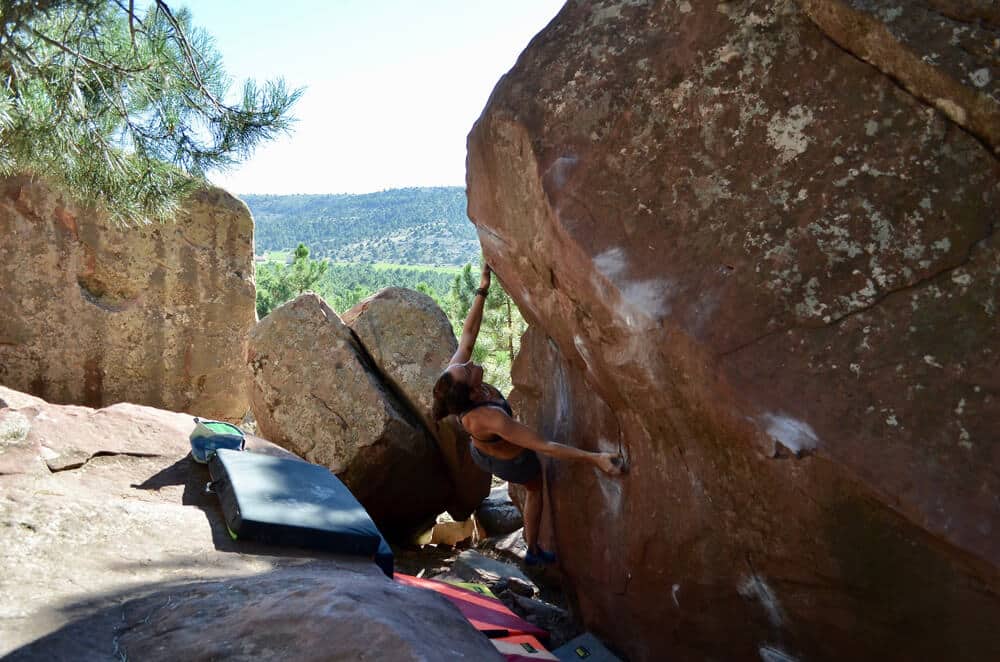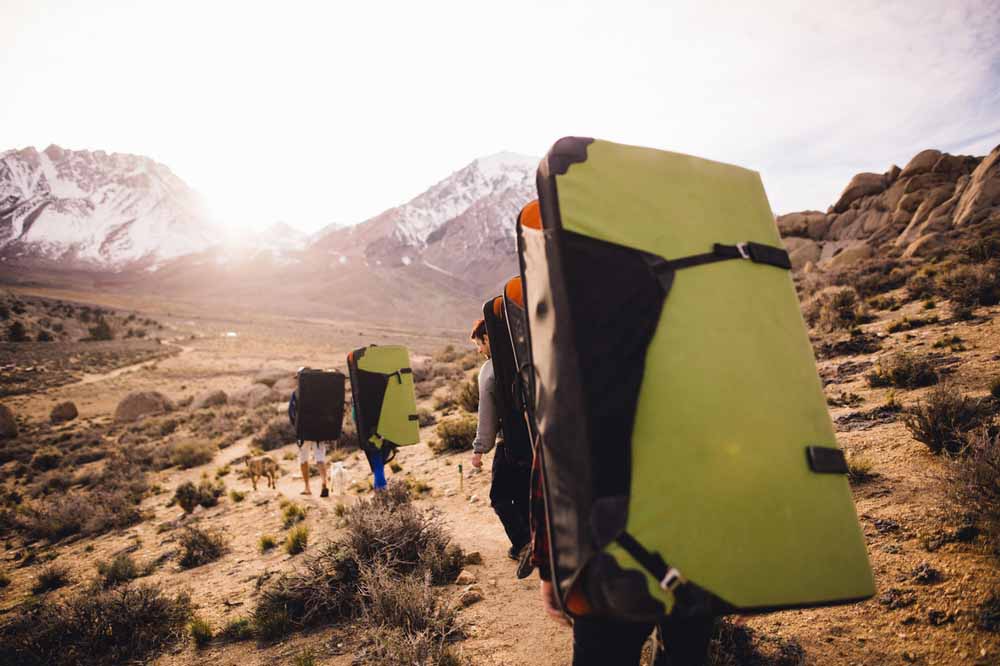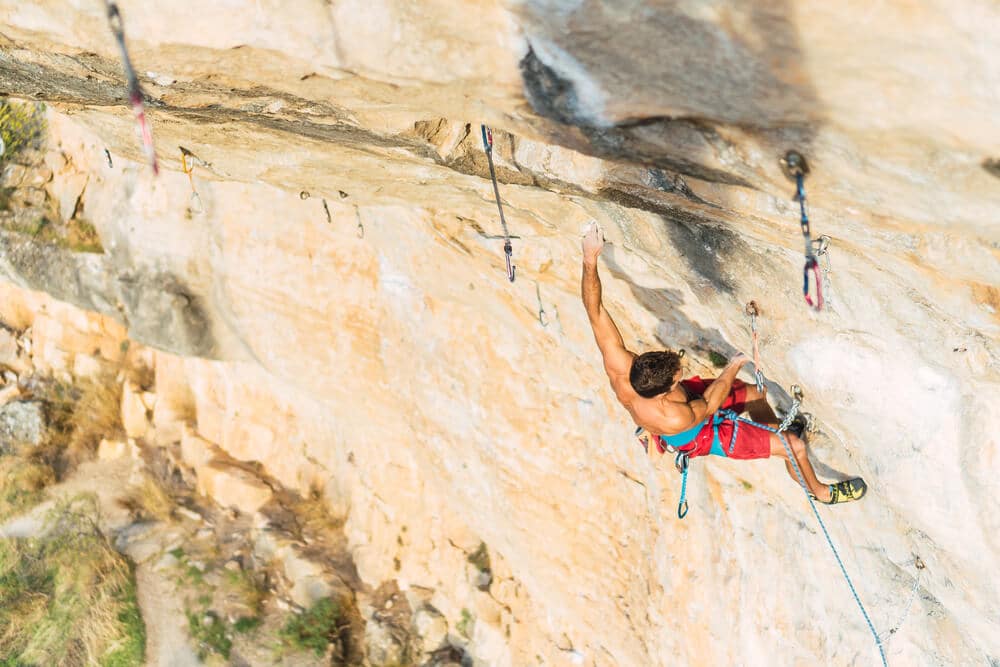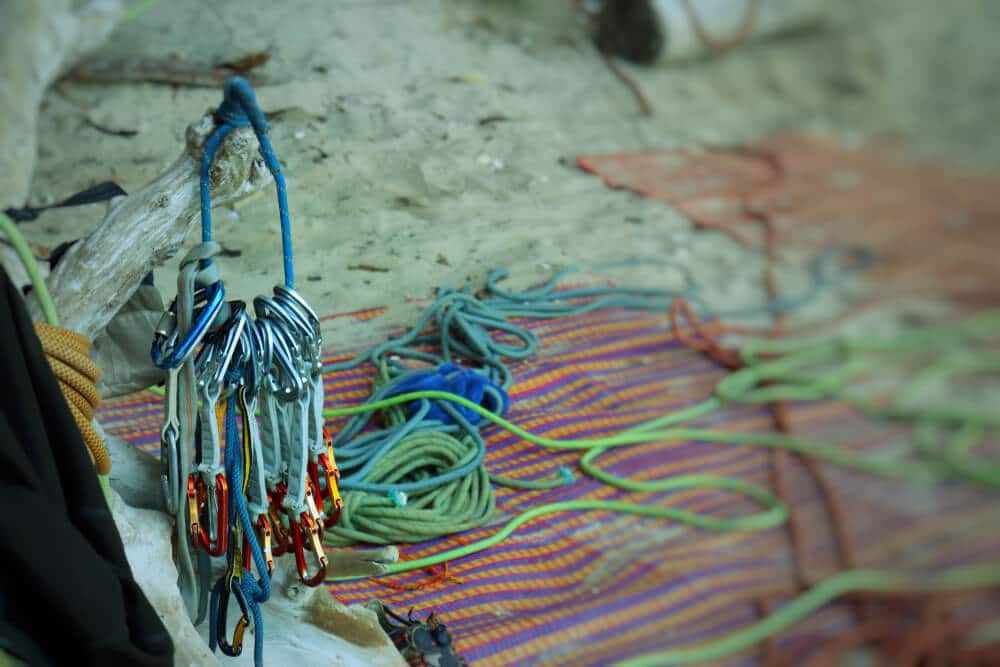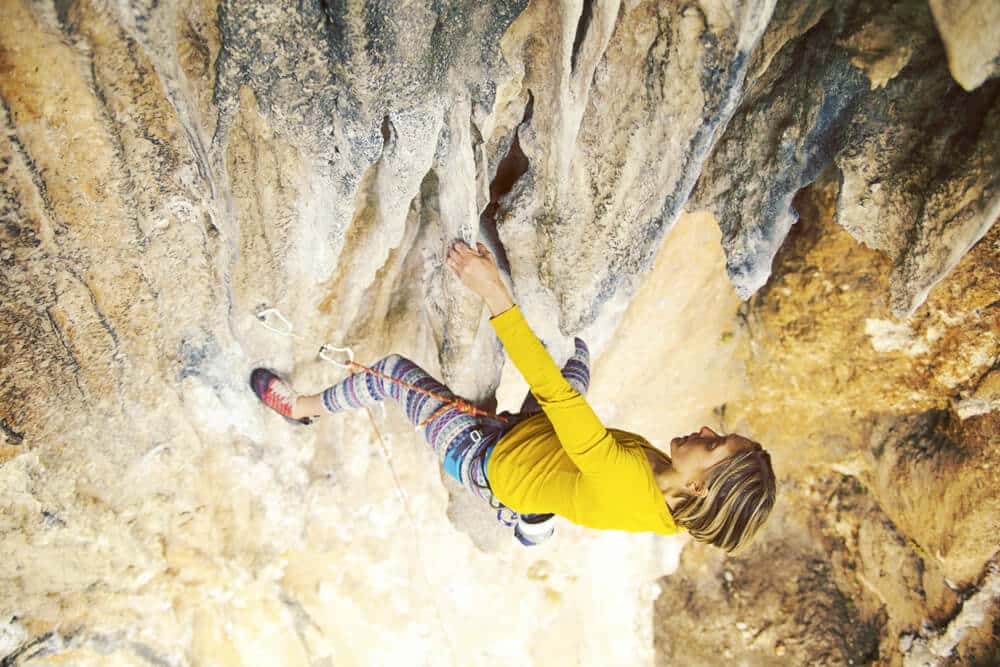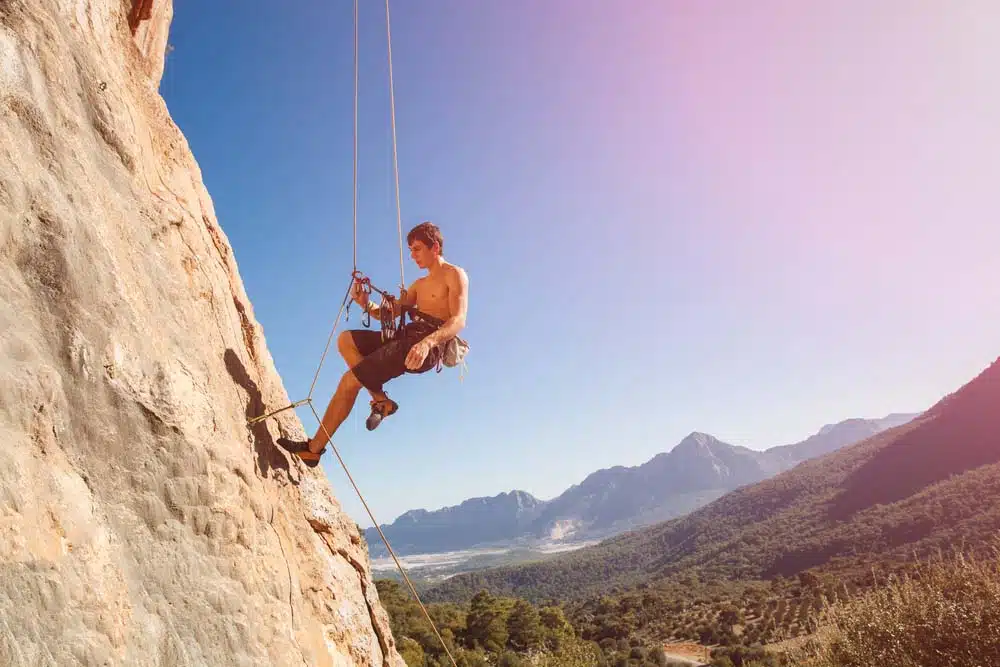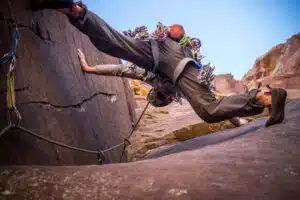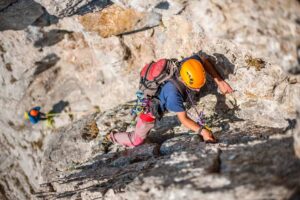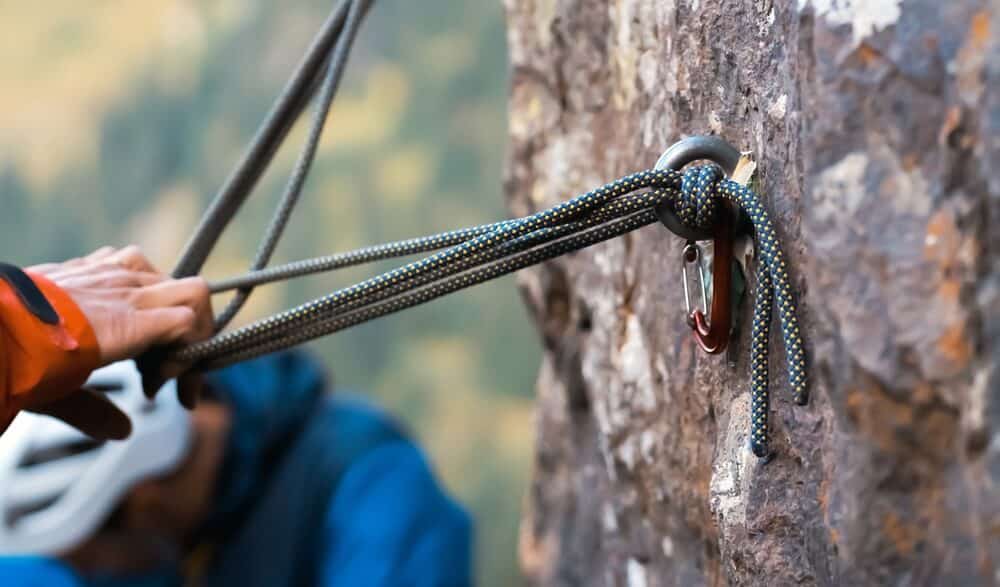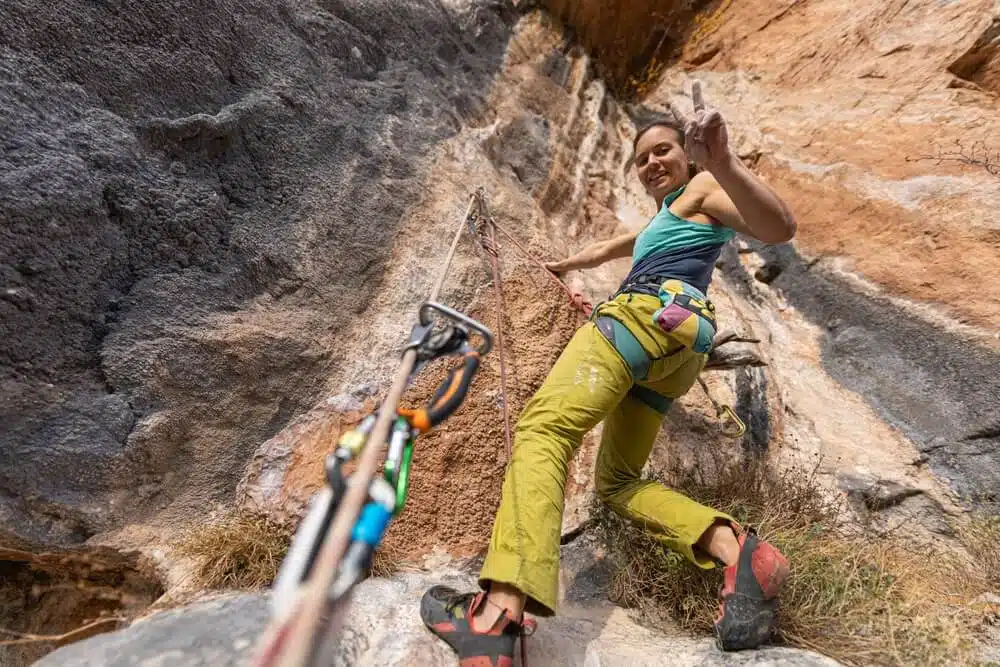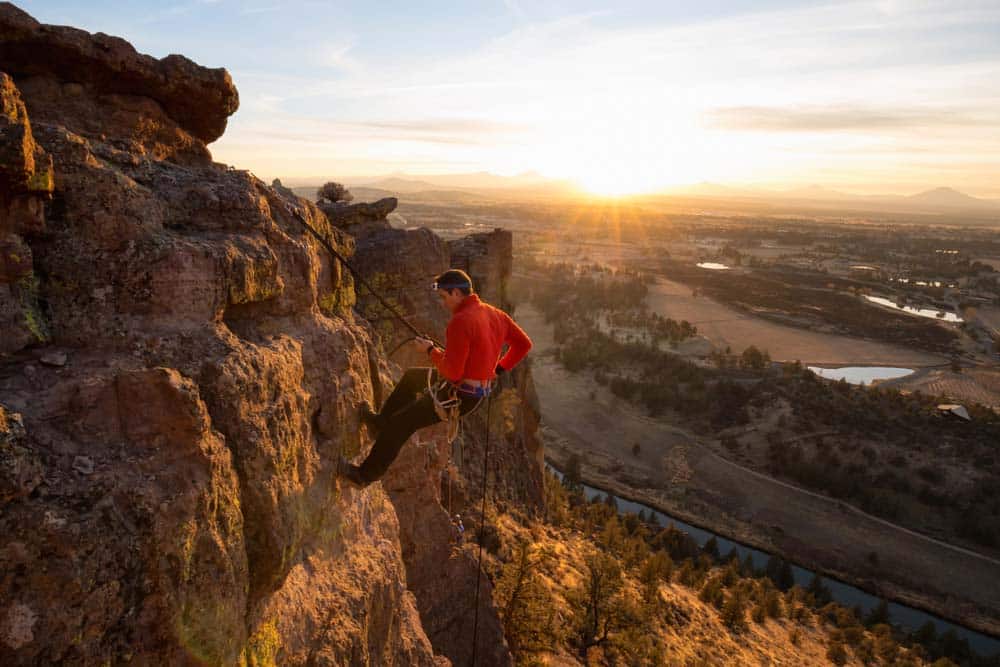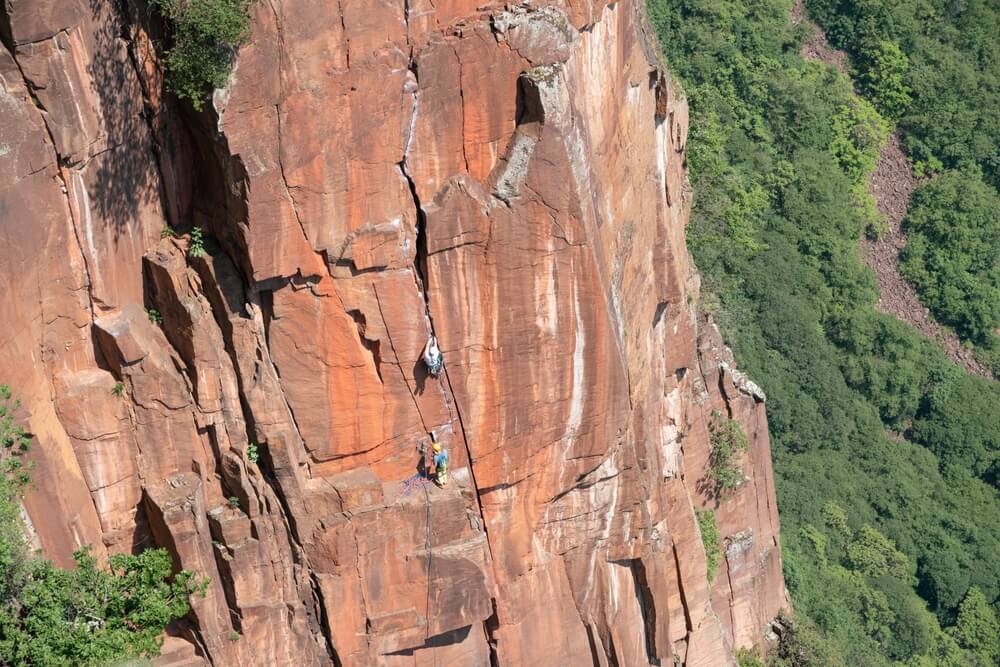If you’ve been gym climbing for a bit and want to start climbing outdoors, it can be hard to know how to begin. This article will provide a guide for getting started climbing outside, as it can be a great activity for both your mental and physical health!
Bouldering Outdoors
Bouldering is one type of outdoor climbing. Just like in the gym, to boulder outside you don’t use any ropes or harnesses and instead ascend short problems and fall onto padding.
Gear Needed for Outdoor Bouldering
You won’t have to buy much new climbing gear!
You’ll need your climbing shoes and chalk, and you’ll also have to supply your own pads. You can buy crash pads such as this one from Metolius.
The number of crash pads you’ll need depends on which boulder problems you’re doing, but most require at least two pads– some need several more than that. Pads are what will keep you safe, so don’t skimp! Try to find friends who also have crash pads so you can combine resources.
That’s pretty much all the gear you need for bouldering outside, but don’t forget to pack plenty of food, water, and a warm jacket.
Skills Needed for Outdoor Bouldering
Many climbers begin their outdoor climbing journey with bouldering because you don’t need a lot of new skills. You should be comfortable falling safely, as bouldering outdoors can be more dangerous than in the gym. You can practice falling in the gym.
The style of the climbs will feel different than indoors, and the grades will probably feel significantly harder, especially at first. You’ll probably have to use smaller footholds than you’re used to, and the beta may not be as obvious as it is in the gym.
Sport Climbing
Another type of climbing that you can do outdoors is sport climbing: roped climbing where you clip the rope to bolts as you ascend the rock.
Gear Needed for Sport Climbing
You’ll definitely need some new climbing gear in order to sport climb outdoors. You’ll still need your climbing harness, climbing shoes, and chalk bag. You’ll also need a climbing rope, but it might be longer than the one you use in the gym. Gym ropes can often be as short as 30 or 40 meters, but for outdoor sport climbing it’s a good idea to have one that’s 60 or 70 meters to ensure it’s long enough to reach the ground when you lower your climber. It’s also nice to have a rope bag to easily move it around the climbing area!
Other gear you’ll need includes a belay device such as a Gri-Gri or ATC. Outdoor climbers should also have a personal anchor system (PAS) for cleaning anchors.
In the climbing gym, bolts have permadraws on them– that’s what you clip the rope into as you lead. But outdoors, you’ll need your own quickdraws. When you’re climbing, you’ll clip one carabiner of the quickdraw to the bolt on the rock, and your rope to the other end.
The number of quickdraws you’ll need depends on the number of bolts a route has: most sport climbs have anywhere between 4 and 16 bolts. Often, you’ll also use two draws at the anchor of the route so that someone else can toprope it, or you can lower off the quickdraws if you’re not the last person to climb.
You should also have a climbing helmet when you climb outdoors. Wearing a helmet is good while climbing, just in case you take a fall where your head hits the rock. The belayer should also wear a helmet in the case of falling rock or gear.
There’s also some optional gear you can choose to purchase. Many experienced climbers like to use approach shoes for the hike to the climbing area. It’s a good idea to bring a simple first aid kit as well.
Skills Needed for Outdoor Sport Climbing
For this discipline of outdoor climbing, you’ll need quite a few skills.
An essential one is being comfortable lead climbing.
In the gym, many climbs may have top ropes already set up that you can use. Outdoors, there may be occasional crags where you can walk around the cliff and set up a top rope from above, but this is not the norm.
Most of the time, you’ll need to have at least one person in your group who is confident lead climbing. And, you’ll need to know how to lead belay so you can keep your climber safe! Other skills you should have for outdoor sport climbs are outlined below.
Cleaning Routes
When you’re lead climbing outside, you’ll clip quickdraws to each bolt as you move up the rock. Before you head to the next route, you’ll need to clean your draws. There’s a couple ways to do this: you can clean them as you lower, or someone else can top rope the climb and clean on the way up.
If no one else is doing the route after you and you don’t want to top rope it yourself, you’ll want to clean as you lower. To do this, it often helps to clip a quickdraw to the rope across from you, and also to your belay loop. This prevents you from swinging away from the wall. As your belayer lowers you, have them pause as you get to each draw so you can unclip it and re-rack it onto your harness.
If someone else is going to top rope the climb, it’s usually best to have them clean quickdraws as they climb. This also provides “directionals” for the top rope climber so they don’t swing if they fall– something that’s especially useful if the climb isn’t straight.
To do this, lower off the climb without cleaning any draws. Then, untie from the rope and pull the rope so the the top rope climber can climb on the other end of the rope– the end that is through all the quickdraws. This way, they can clean each draw when they pass it while climbing. This technique is especially useful on overhung climbs, where it can be challenging to clean while lowering.
Anchor Building
Among the skills climbers need for outdoor climbing is anchor building. When you get to the top of a climb, you’ll need to get the rope anchored if anyone else wants to top rope the climb. It’s good climbing etiquette to top rope off of your own gear instead of off the gear that’s already there– that way you minimize the wear on the fixed gear that everyone uses.
On single pitch climbs with bolted anchors, a simple quickdraw anchor usually works well. Clip a draw to each bolt of the anchor (you can clip directly to the bolt or to a link on a chain). Make sure the two quickdraws hang at the same level. Then, clip the rope into the two draws so the gates are opposite and opposing.
Sometimes, you’ll need to set up a more complex anchor. This is common if you’re at an area where top roping is possible without leading. In that case, the anchor bolts are likely over the edge of the cliff so they can be accessed from above. To set up an anchor like this, you’ll need the right gear: some locking carabiners, cordelette, and slings will usually be sufficient.
It’s also good to know a few knots for building anchors like this. A couple to learn include a figure eight on a bite and a clove hitch.
Cleaning Anchors
Another important skill you’ll need to start rock climbing outdoors is cleaning anchors. When you’re climbing indoors and you get to the top of the climb, you simply come down. But outdoors, you need to clean the anchor.
Let’s say you’re top roping the climb, and you’re the last person who’s going to do it. When you get to the top, you need to collect all the personal gear that your group has been using (i.e. the quickdraws that are at the anchor).
To do this, you’ll usually clip into the anchor with a personal anchor system (PAS). It’s a good idea to never depend on only one bolt. So, if you clip your PAS into the chain on one anchor bolt, you can clip a quickdraw into the other bolt (and your belay loop).
Next, weight your PAS to make sure that your setup is secure and communicate that you are “in direct” to your belayer. They should give you slack, and you can pull up some rope (8 feet or so) and tie an overhand on a bite. Clip this bite to an extra draw on your harness in case you drop the rope. Then, untie your figure eight knot and remove the quickdraws that were being used for the anchor.
Thread the rope through the rings on the bottom of the chains on the anchor bolts. Pull quite a bit of rope through, re-tie a figure eight and tie back into the rope. Then, untie your overhand on a bite and have your belayer take up all the slack. Weight the climbing rope, and then remove your PAS and the quickdraw that was connecting you to the other bolt. You should have cleaned all the personal gear from the anchor at this point, and your belayer can lower you to the ground.
Rappelling
Most outdoor climbers learn to rappel at some point. Rappelling is a way of lowering oneself off a fixed anchor. Instead of having your belayer lower you after cleaning an anchor, sometimes you may choose to rappel.
Rappelling puts less wear on the anchors than lowering does, so if the anchors are in a high-traffic location or in a place where anchors are not replaced often, you may want to rappel. If the anchors you’re lowering off are at all suspect, rappelling can be a safer choice since it puts less pressure on the fixed gear.
To rappel, you’ll need a device such as an ATC. Check out options such as the Black Diamond ATC— it’s affordable, easy to use, and can also be used as a belay device. Clip your ATC to your belay loop with a locking carabiner. Thread the rope through the chains and pull it until the midpoint is right at the anchor. You’ll also need to tie ends in both ends of your rope to ensure you don’t rappel off the ends of your rope.
Then, unclip your ATC and load both strands of rope into it. ATCs are usually marked to show your where the brake strand and the climber strand should go. The climber strand is the one that goes to the anchor, while the brake strand is the one the goes to the ground. After loading your ATC, clip it back onto your belay loop and lock the carabiner. Weight your ATC before removing your PAS, and you can then slowly feed slack into the ATC to lower yourself. Always keep a hand on the brake strands while rappelling! It’s a good idea to back up your ATC with a prusik.
Other Advice
There’s a lot to think about if you want to begin rock climbing outdoors. If you feel confused about any of the skills or processes, it could be a good idea to seek proper instruction from a guiding company or class.
When you start climbing on real rock, it will likely feel quite a bit harder than the gym. Unless you’re a very experienced climber that has been gym climbing for a few years, plan to start by doing very easy climbs so you can build confidence. When outdoor climbing, you have to find your own way up the rock instead of having clearly marked plastic holds!
One piece of climbing etiquette to keep in mind when you’re climbing real rock is to wipe off tick marks when you’re done with a route. Many people find it helpful to tick certain holds with chalk when climbing outdoors so you can know which holds to use on your next try. When you’re done with the route, you should wipe these marks off so other climbers can attempt without them.
Another piece of advice is to consider your climbing shoes carefully! The shoes that work well for you in the gym may not perform as well when you are climbing outside. For outdoor climbing, choose rock shoes that are stiff and can stand well on small edges, such as the Tarantulaces.
Other Types of Climbing
There are other types of outdoor rock climbing, but they’re probably not the best place to start if you’re new. This includes multi pitch climbing, trad climbing, and aid climbing. As you have more and more outdoor climbing experiences, you can work towards these more advanced types of climbing.
Conclusion
It can be hard to know how to approach outdoor climbing! It’s definitely more technically advanced than indoor climbing, but with the information in this article you should be a step closer to beginning your journey of climbing outside.


